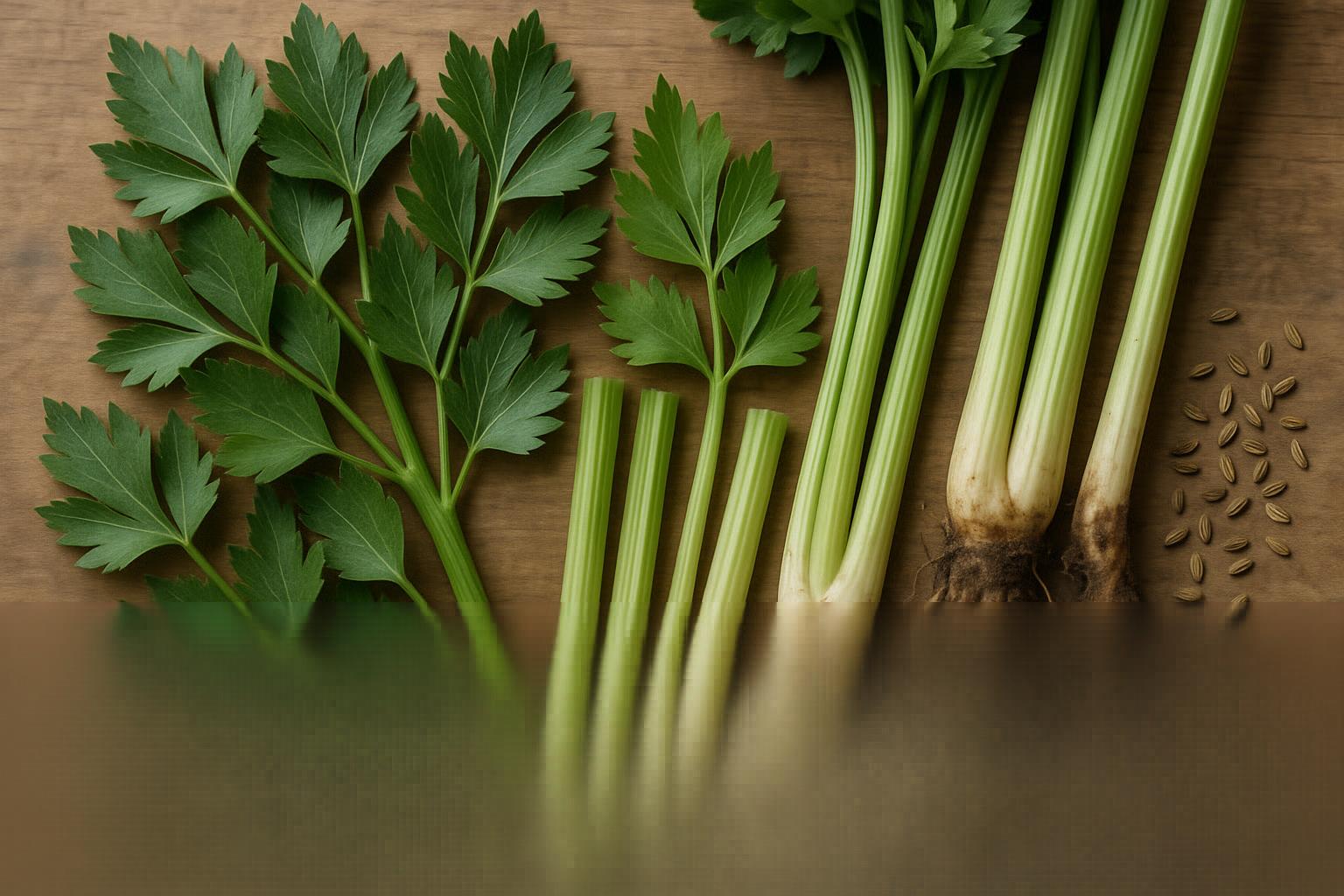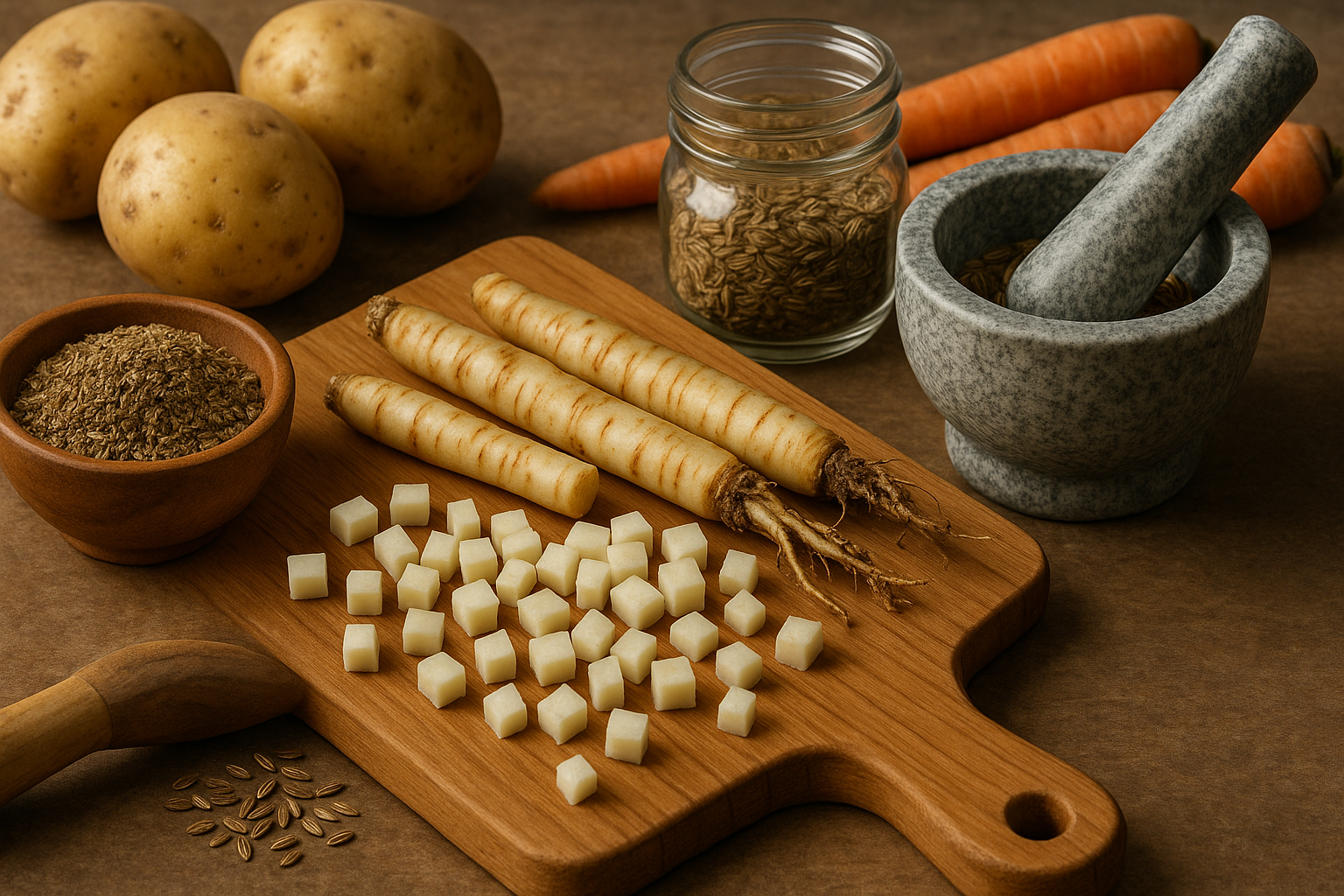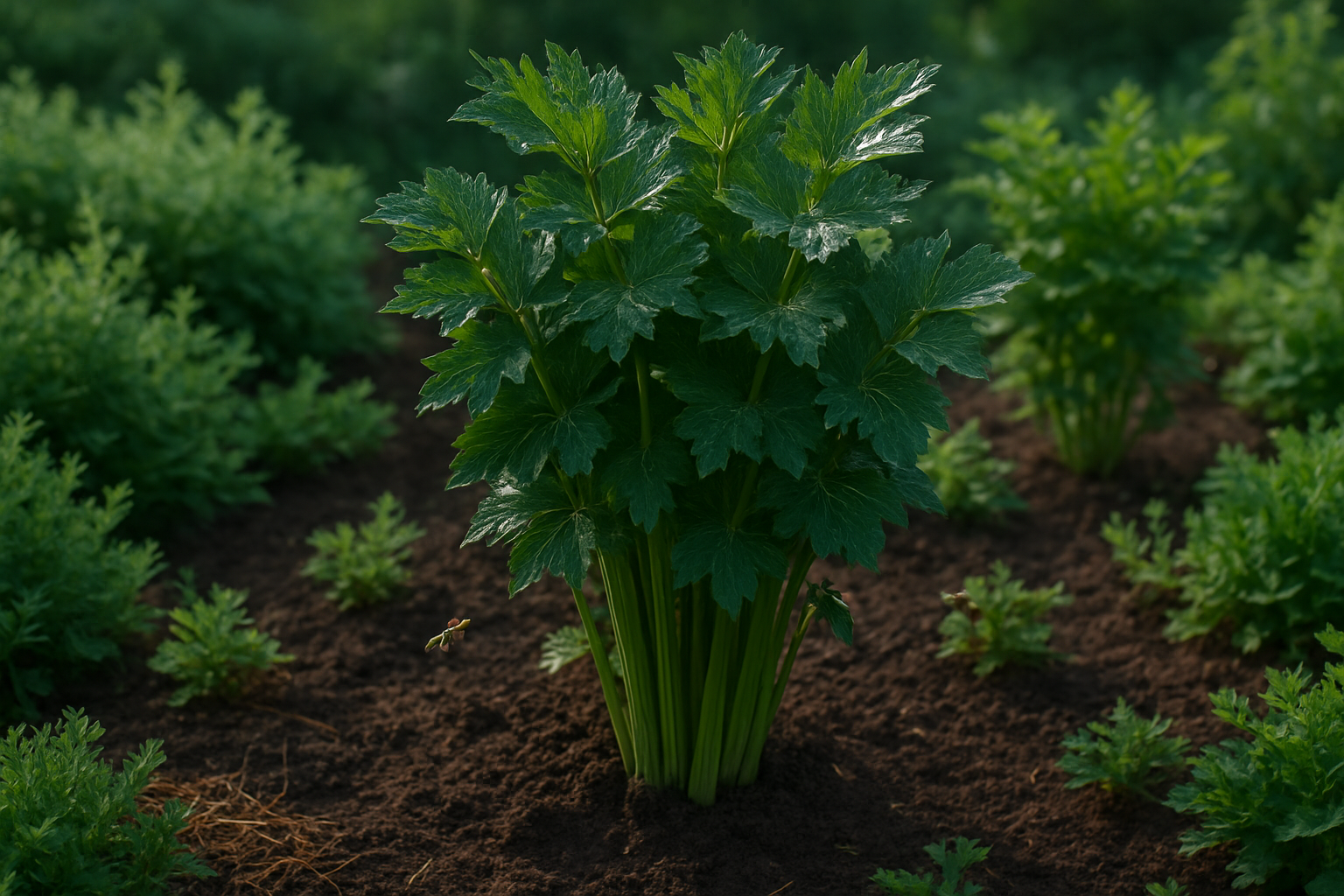What is Lovage?

Lovage (Levisticum officinale) is a robust, perennial herb native to Southern Europe but now widely grown in herb gardens around the world. Recognizable for its tall, celery-like stems and lacy, dark green leaves, lovage belongs to the Apiaceae family, the same group that includes carrots, parsley, and dill. The plant can grow up to six feet tall, making a striking addition to any herb bed.
Every part of lovage is edible and has been used in both historical and modern kitchens. The leaves and stems bring a punchy, celery-meets-parsley flavor to salads, soups, and stews, while its aromatic seeds are often used as a spice, similar to celery seed, for seasoning breads or pickling mixes. Even the roots, which resemble parsnips, can be eaten raw, cooked, or used to create tonics.
Lovage has a long heritage: Romans prized it as both food and medicine, adding it to savory dishes or using it to soothe stomach issues. In the Middle Ages, lovage was common in monastery gardens for its healing properties and its ability to add depth to broths before celery became widespread.
For today’s cook, a handful of chopped lovage can enliven potato salads, stir-fries, or compound butters. Its intense flavor means a little goes a long way—think of it as a secret ingredient that bridges the gap between tradition and contemporary cuisine, while also offering a sustainable alternative to store-bought celery.
Are Lovage Seeds Edible?
Lovage seeds are indeed edible and hold a valued place in both traditional and modern kitchens. Their safety for consumption is well-established, as they have been used for centuries as a versatile spice and natural remedy. Nutritionally, lovage seeds offer a modest amount of minerals and antioxidants, making them a great way to add flavor without extra calories or salt.
Culinarily, their profile is reminiscent of celery and fennel, with a sharp, peppery edge and subtle hints of anise and parsley. This bold flavor has made lovage seeds popular for seasoning stews, soups, and even pickling brines.
Traditional and Modern Uses
In traditional cooking, especially in Central and Eastern Europe, the seeds were often ground and used in place of celery seeds or included in spice blends for sausages and baked goods. Herbalists have long recommended lovage seeds for digestive support, believing they can soothe bloating and help relieve gas.
These days, adventurous home cooks and mixologists are discovering that crushed lovage seeds make a unique addition to homemade spice rubs, salad dressings, and even craft cocktails. Their aromatic bite can elevate a Bloody Mary or a savory gin infusion.
Preparation and Storage
Preparation is typically straightforward: you can use the seeds whole in slow-simmered dishes, toast them lightly to enhance their flavor, or grind them into a spice blend. To maximize freshness and intensity, it’s best to store lovage seeds in an airtight container away from light and heat.
Whether you’re exploring age-old recipes or creating new flavor combinations, lovage seeds deliver a punch of character sure to spark curiosity and delight your taste buds.
Can You Eat Lovage Roots?
Yes, you can eat lovage roots—they’re an often underrated part of this aromatic herb. Like the plant’s celery-like stems and leaves, lovage roots have a bold, earthy flavor, but they tend to be more pungent and slightly spicy. Think of a cross between celery, parsley root, and parsnip.
Though not as common as potatoes or carrots in the kitchen, lovage roots have long been used in traditional European recipes. They are often diced and added to hearty soups or stews for a deep, herbal undertone. You can also roast them alongside other root vegetables or use them to infuse broths, adding a unique savory note.
Beyond cooking, lovage roots have a history in folk medicine. Teas brewed from dried roots are reputed to aid digestion and soothe bloating.
How to Use Lovage Roots
- Harvest mature roots in the fall, when the plant’s leaves begin to die back.
- Scrub the roots thoroughly to remove dirt, then peel before chopping or slicing.
- Use lovage roots in moderation—like other potent herbs, they work best as a flavor accent rather than a main ingredient.
- Be cautious, as consuming large quantities can irritate sensitive stomachs.
- If you’re pregnant or have kidney issues, consult a healthcare provider before trying lovage roots, since they contain compounds that act as diuretics.
Try simmering a few thin slices in a homemade vegetable tea, or add finely grated root to mashed potatoes for a surprising twist. Always positively identify your harvest, as lovage is a perennial herb sometimes mistaken for wild toxic plants like poison hemlock.
With a bit of care and creativity, lovage root can add depth and old-world charm to your kitchen repertoire.
Health Benefits and Potential Side Effects
Lovage seeds and roots have a long history in traditional medicine and cuisine, valued for both their flavor and health-promoting properties. Rich in antioxidants, vitamins C and B-complex, and essential minerals such as potassium and magnesium, lovage is known to support immune function, digestion, and heart health.
Its seeds are particularly noted for their carminative effects, helping to relieve bloating and gas, while the roots have traditionally been used as a gentle diuretic, aiding in the reduction of water retention and natural detoxification. Some herbalists recommend lovage tea for soothing sore throats and easing respiratory discomfort, while others praise its potential to reduce inflammation and support urinary tract health.
However, as with any herbal product, there are potential side effects and important considerations to keep in mind.
Potential Side Effects and Precautions
- Lovage contains compounds that may increase sensitivity to sunlight, potentially leading to skin irritation for some individuals.
- Allergic reactions, though rare, can occur—especially in those sensitive to plants in the Apiaceae family, such as celery or parsley.
- Pregnant and breastfeeding women are advised to avoid lovage because it may stimulate uterine contractions, and its safety for infants has not been established.
- As a natural diuretic, lovage can interfere with certain medications for high blood pressure, kidney disorders, or lithium treatment. It’s crucial for people with these conditions to consult their healthcare provider before use.
- Those with a history of kidney stones should exercise caution since lovage contains oxalates that could contribute to stone formation.
In summary, lovage offers several nutritional and health benefits when used thoughtfully. However, it’s important to be aware of its potential side effects and to consult your doctor if you have any underlying health conditions or are taking regular medications.
How to Use Lovage Seeds and Roots in the Kitchen

Lovage seeds and roots are hidden gems for any adventurous cook, offering a bold, celery-like flavor that can liven up both everyday and special-occasion dishes. You can source lovage seeds at well-stocked spice shops, health food stores, or online retailers—and even harvest your own if you grow the plant. The roots, less common but worth seeking out at farmers’ markets or specialty grocers, should be firm and free from mold.
For storage, keep seeds in a cool, airtight container away from sunlight to retain their potency for months. Roots should be scrubbed, trimmed, and stored in the fridge, where they’ll stay fresh for a week or two.
To use them, gently crush the seeds to release their aroma, and sprinkle them into bread dough, salad dressings, or homemade spice blends for a distinctive, slightly peppery note. Try tossing them with sea salt and black pepper on roasted potatoes, or add them to brine for pickled vegetables.
Lovage roots can be peeled and diced, then simmered in broths, stews, or creamy soups, much like celery root. For a simple herbal tea, steep a spoonful of dried or fresh lovage root in hot water, possibly combined with parsley or dill.
Lovage pairs beautifully with potatoes, carrots, chicken, and fish, and is a classic in Central and Eastern European recipes like potato soup or borscht. Experiment with seeds in spice rubs for roasted meats, or even add a pinch to gin or vodka infusions for a savory twist.
With its versatility, lovage brings a punch of garden freshness to a surprising range of recipes.
Precautions and Safe Consumption Guidelines
When incorporating lovage seeds and roots into your routine, moderation is key to avoiding potential side effects. For culinary use, small amounts—like a pinch of ground seeds in soups or a few fresh root slices in salads—are generally considered safe for most healthy adults.
However, medicinal use calls for greater caution. Typical doses found in herbal supplements range from 1 to 2 grams daily, but you should never exceed the recommended amounts on product labels. Overconsumption may lead to increased skin sensitivity to sunlight, digestive upset, or more serious concerns due to lovage’s diuretic properties, which can affect hydration and kidney function.
It’s especially important for pregnant or breastfeeding women, children, and people with kidney disorders, electrolyte imbalances, or allergies to carrots, celery, or similar plants to consult a healthcare professional before using lovage in any form. If you’re taking prescription medications—particularly blood thinners, diuretics, or medications that affect kidney health—check with your doctor to avoid unwanted interactions.
Start with the lowest possible dose and monitor how your body reacts. Discontinue use if you notice rash, swelling, or digestive discomfort. Never use lovage as the sole treatment for any medical condition.
By following these guidelines and maintaining open communication with your healthcare provider, you can explore the benefits of lovage safely and confidently.
